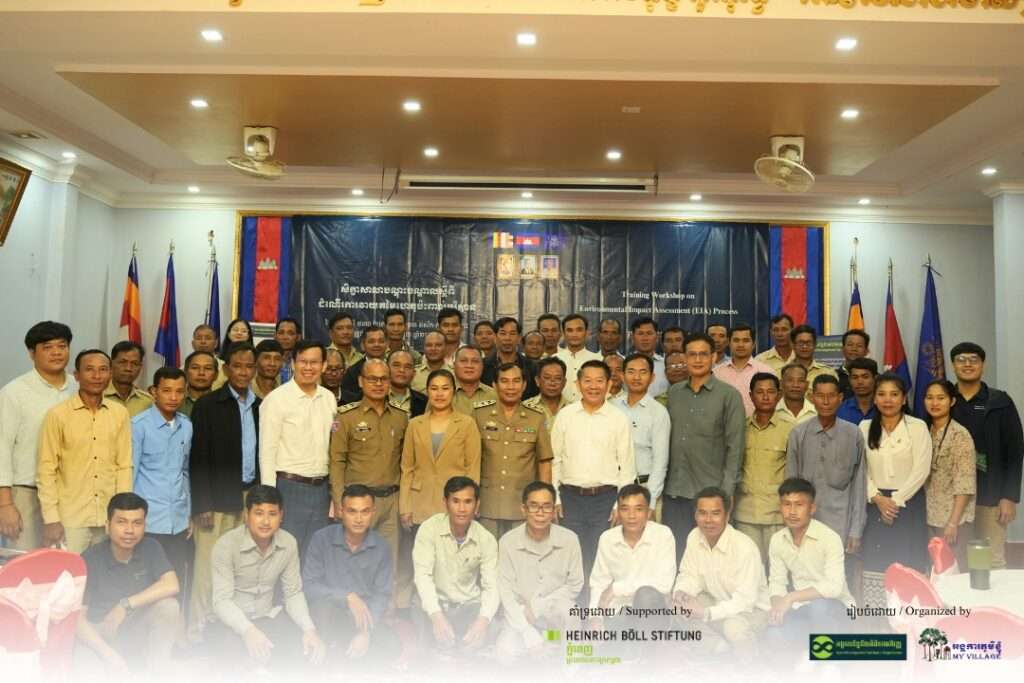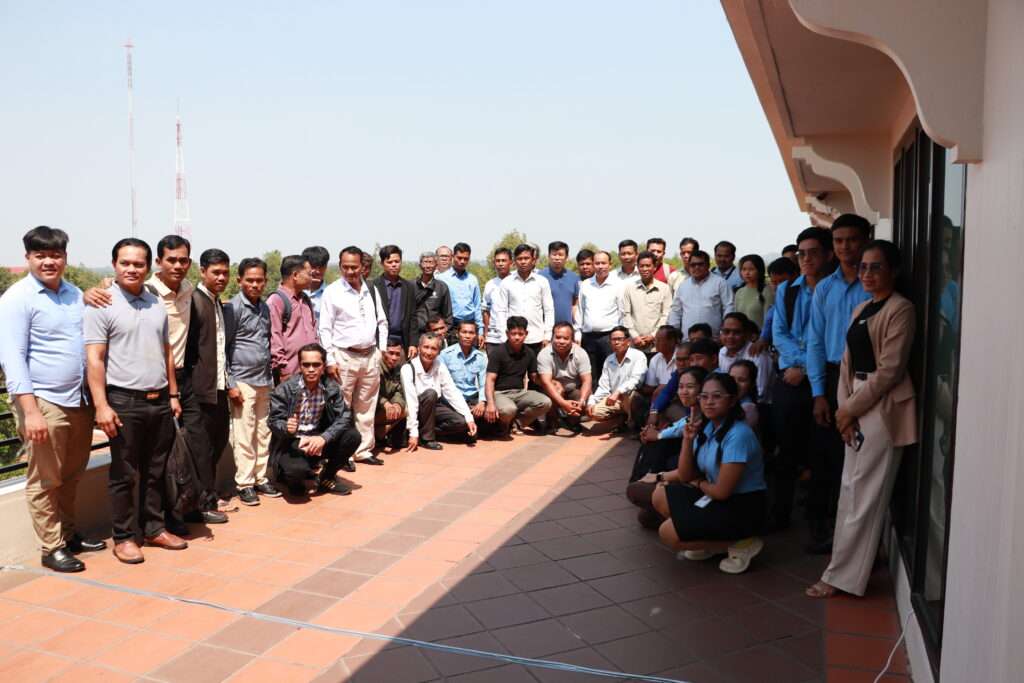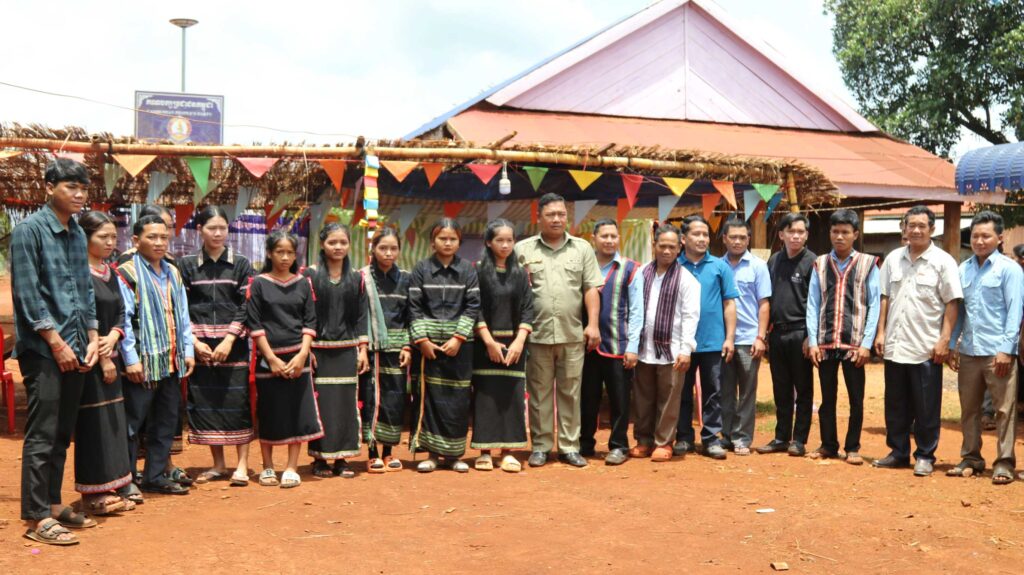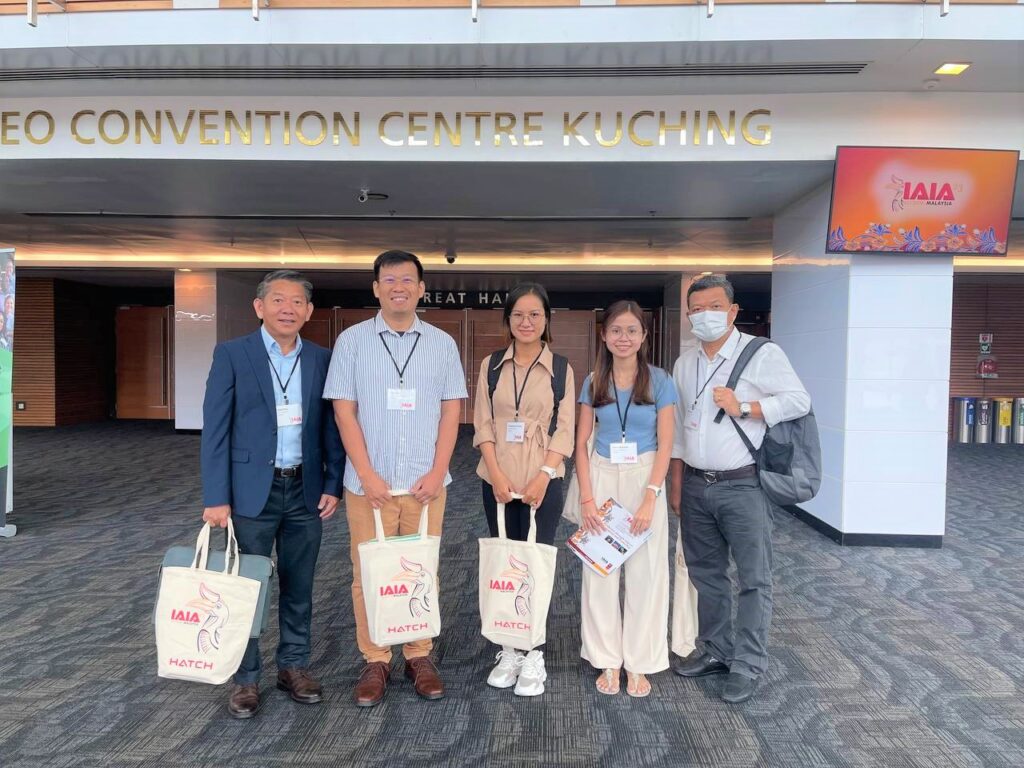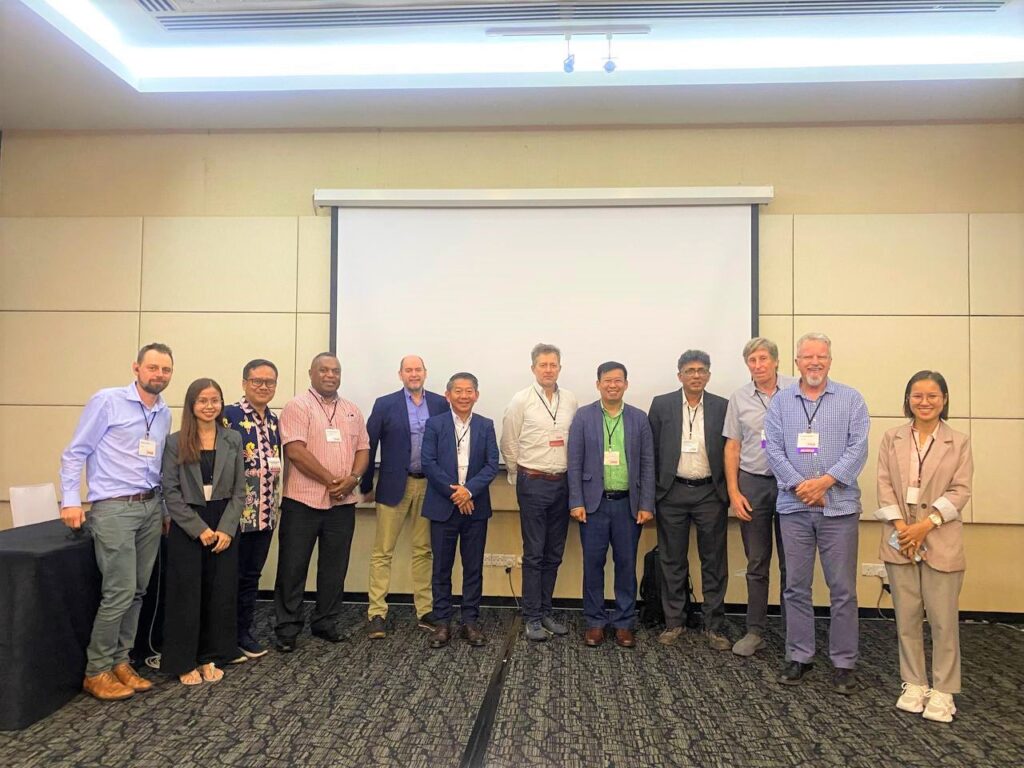Raise awareness of the communities on environmental impact assessment process
On 25 July 2025, Open Development Cambodia Organization (ODC) in collaboration with My Village Cambodia (MVi), under the project \"Enhancing Natural Resource Management Governance through Data-Driven Approaches,\" conducted an important training workshop on environmental impact assessment (EIA) in Mondulkiri province. This event aimed to raise awareness of the local communities and authorities with essential knowledge regarding EIA, fostering informed decision-making and active participation in environmental governance. The workshop gathered 60 participants, including representatives from the EIA Department of the Ministry of Environment, Mondulkiri Provincial Administration, Provincial Department of Environment, Provincial Department of Land Management, Urban Planning, Construction and Cadaster, local authorities, and community members. Despite the technical nature of EIA, the event emphasized the importance of community involvement in the EIA process. Welcoming remarks by Mr. THY Try, Executive Director of ODC Mr. THY Try opened the workshop by highlighting the alignment of the event with the Environment and Natural Resource Code (ENR Code), which mandates comprehensive EIA processes for development projects. He emphasized the critical role of EIA in sustainable development and encouraged participants to be actively involved in discussions, asking questions to extend their understanding and concerns. He also introduced the availability of the EIA and Foreign Investment Mapping (FIM) profile pages on the ODC website, expected to enhance public access to data. Opening remarks by Mr. NGIN Sovimean, Deputy Mondulkiri Provincial Governor Mr. NGIN Sovimean expressed his appreciation to participants and organizers, particularly acknowledging ODC and MVi’s efforts in hosting this event. He highlighted Mondulkiri’s developmental achievements across education, health, tourism, infrastructure, and agriculture sectors, emphasizing the essentials for sustainable development practices. Mr. Sovimean emphasized the province\'s commitment to applying EIA for informed decision-making. Detailed EIA process and legal framework presentation by Mr. CHEA Leng Mr. CHEA Leng, Deputy Director of the EIA Department at the Ministry of Environment, presented a comprehensive overview of the EIA process and its legal framework. He facilitated discussions, encouraging participants to share their experiences and challenges related to EIA. The workshop revealed varying levels of awareness among participants about EIA. Some were well-informed and actively participated in the EIA process, while others were unfamiliar. These discussions highlighted the need for continuous training and better communication regarding EIA, especially in the community. The Q&A session provided valuable insights into the EIA process. Participants raised concerns about specific projects and their impacts on local communities. Mr. CHEA Leng clarified that communities have the right to raise concerns and emphasized the importance of public participation in EIA. He also addressed misunderstandings about EIA delaying development, explaining that it aims to mitigate the environmental and social impact of the development projects. Key issues and community involvement Participants emphasized the need for clear and timely communication about development projects. They raised the community’s challenges including incomplete information, difficulty negotiating compensation for affected communities, limited internet access, and language barriers. They suggested the government improve internet services, ensure information is available in local languages, provide timely meeting notifications, and request more comprehensive documentation from project owners. Addressing these barriers can significantly expand information flow and community involvement and facilitate better decision-making and conflict mitigation. Presentation on the FIM and EIA profile pages by Mr. BAN Chanphalla Mr. BAN Chanphalla highlighted ODC’s role in promoting transparency and accessibility of development-related data through the Foreign Investment Mapping (FIM) and EIA profile pages. The page features key information about foreign investment projects and EIA reports, enhancing public awareness and participation in environmental governance. Closing remarks by Mr. Lonn Pichdara, Executive Director of My Village Cambodia (MVi) Mr. Lonn Pichdara concluded the workshop by thanking all participants and partners. He emphasized the importance of transparent information sharing and the need for further training and support for local communities. Mr. Pichdara recognized the workshop\'s significance in disseminating critical information and fostering stakeholder collaboration.
Civil society’s participation in the draft Land Law dialogue for land rights protection
The Cambodian government has drafted an entirely new Land Law (the draft law), more than 20 years after the promulgation of the 2001 Land Law. Acknowledging the importance of participation from civil society, local communities, and indigenous peoples (IPs), Open Development Cambodia (ODC) formally sought an opportunity to review the draft law and was able to provide constructive inputs based on dialogues with relevant stakeholders. In late January 2024, the Ministry of Land Management, Urban Planning and Construction (MLMUPC) drafted a comprehensive new Land Law, comprising seven titles, thirteen chapters, and a total of one hundred and ninety-nine articles. ODC formally submitted an official letter to the MLMUPC, requesting an opportunity to review and provide constructive inputs on the draft law. The MLMUPC approved the request and shared the draft law with ODC, providing a short window until 16 February 2024 for submitting inputs. Dialogues highlighting key issues such as the need to protect collective rights, in particular, the rights of Indigenous peoples ODC hosted two dialogues on the draft new Land Law – one on 13-14 February in Siem Reap Province and another on 15 February in Phnom Penh. The two dialogues were supported by the United States Agency for International Development (USAID) through Family Health International (FHI 360) under a Cluster Anchor Grant from the Civil Society Support (CSS) Project, ALIGN and LANDESA. During the first dialogue, a Cambodian legal expert presented an analysis of key articles of the draft Land Law to the participants. The participants then discussed and provided their inputs, concerns, and recommendations for the draft law. Representatives from Indigenous peoples’ (IP) communities who were present during the dialogue raised concerns about the limited time provided for comprehending the proposed legal amendments, conveying their understanding to the communities, and gathering inputs from their members. They felt that the dialogue was more of an informative session than a consultative one. As a result, representatives from the indigenous communities were unable to provide their input on the draft law and requested an extension of time for the consultation process. ODC and our partners sympathized with the response from the IP communities, as the timeline for the input was also a huge challenge for the team. The second dialogue was held on 15 February in Phnom Penh, to consolidate the inputs and recommendations derived from the first dialogue in Siem Reap Province. Following the dialogues, ODC and partners prepared and submitted the consolidated inputs and recommendations to the MLMUPC. The document is published on the ODC website, and is publicly accessible. The document highlights several key issues, such as the need to clarify the protection guarantees for collective ownership, right to use, right to enjoy the fruit of the land and rights related to land and other immovable properties of IPs and Buddhist monasteries. The input also requested further consideration towards gender equity and the protection of the rights of IPs and local communities. In early March, ODC attended a meeting hosted by the Land Law Working Group at the MLMUPC. According to the MLMUPC, more than 15 inputs from ODC were incorporated, including issues regarding the classification of public state land and private state land, the timeframe for the registration of communal land titles for IPs, promotion of equity in land rights and land administration, the specification of a timeframe for complaints, a filing process for complaints, and elaboration on the glossary. ODC and our partners shared concerns regarding the time window for the submission of input. The time window for translating the draft law into English and sharing it with our international legal experts, as well as holding dialogues, meant that the input document did not cover all the key points as thoroughly as it could have, if more time were given in the first round. After the input submission, ODC hosted additional discussions and meetings and collaborated with partner organizations to gather more inputs. On 11 March 2024, ODC hosted a knowledge sharing session on Women\'s Rights in Land Ownership and Natural Resource Management (NRM). Additionally, on 22 March 2024, ODC attended a meeting held by the Land Law Working Group of the MLMUPC to discuss the inputs that the working group has received so far. On 26 March 2024, ODC attended another workshop hosted by MLMUPC on the draft law. Then, on 26 April 2024, ODC and partner organizations supported a meeting organized by My Village (MVi) for consultation on the draft law, focusing on the process and challenges of indigenous communal land titling. According to a Ministry officer, MLMUPC will continue to review and incorporate inputs as appropriate and will share a further revised draft law with relevant stakeholders. Based on that advice, ODC and partner organizations continued to review and collect further inputs for the revised version of the draft law and submitted our second round of inputs on the revised draft law on 7 June 2024. On 19 June after submission of our inputs on the revised draft law, MLMUPC shared with ODC the latest version of the draft law. ODC observed that none of our second round of inputs were taken and incorporated in the latest draft. ODC and partner organizations wish to be given further opportunity for a more constructive and serious consultation with the MLMUPC to discuss our inputs point by point. The importance of national and international alliances to ensure an inclusive land law reform that protects the rights of all citizens The collaboration with ALIGN and LANDESA has enabled ODC to engage in consultations with national and international stakeholders on the land law reform process in Cambodia, aligning with relevant international standards and principles of responsible investment in land governance. By uniting all stakeholders, ODC tries to promote transparency and responsible investment in land in Cambodia. The inputs submitted by ODC amplify the voices of local communities to the government, an important factor for promoting sustainability and inclusivity in land rights for every Cambodian. While not all inputs and recommendations from ODC and our partners are expected to be taken by the government, the collaboration has sparked important discussions, particularly concerning land rights and land administration among underrepresented groups such as IPs, women, widowers, and LGBTQ+ individuals. Moving forward, ODC commits to continue working with partner organizations and stakeholders to discuss and explain our second round of inputs and provide more precise and complete suggested changes to the draft law to ensure that the new law is enabling, inclusive, equitable and effective, with minimized unintended negative impacts on vulnerable groups such as traditionally separated spouses, IPs and their communities, LGBTQ+ and unregistered land possessors, and avoiding regulatory or administrative taking of land and immovable property rights without fair and just compensation.
Empowering women’s rights in land ownership and natural resource management: Insights from a knowledge-sharing event
On 11 March 2024, Open Development Cambodia Organization (ODC) in collaboration with Gender and Development for Cambodia (GADC) with funding from the United States Agency for International Development (USAID) through Family Health International – Civil Society Support Activity (FHI360-CSS), Advancing Land-based Investment Governance (ALIGN), and Landesa hosted an important discussion on “Women’s rights in land ownership and natural resource management (NRM)” at the Heinrich Boell Stiftung (HBS) Office in Phnom Penh with 22 enthusiastic participants (15 females) from various organizations. “Why was this event so significant?” It aimed to foster an inclusive dialogue about gender equality and women\'s participation in Cambodian land and natural resource governance. Just a month earlier, on 01 February 2024, ODC received an important letter from the Ministry of Land Management, Urban Planning, and Construction (MLMUPC) regarding the draft land law. This encouraged a series of dialogues with various stakeholders to review the draft and gather inputs. The goal of this discussion was not to gather inputs for the draft land law, but rather to share experiences and knowledge about women\'s challenges in land and natural resource management. ODC opened the event with a keynote speech emphasizing the commitment to gender equality in land ownership and NRM. ODC thanked all participants and highlighted the importance of open dialogue. The goal was to foster an environment in which everyone felt encouraged to freely share their ideas, resulting in a comprehensive post-discussion report. The discussions explored Cambodia\'s legal landscape regarding women\'s land rights. The Cambodian Constitution, particularly Articles 31 and 45, expressly guarantees women\'s rights and prohibits discrimination against them. Cambodia\'s commitment to international human rights instruments, such as the Convention on the Elimination of All Forms of Discrimination Against Women (CEDAW), strengthens these rights. Global frameworks such as the Sustainable Development Goals (SDGs) and regional initiatives such as the ASEAN Gender Mainstreaming Strategic Framework both promote gender equality in land rights. The participants\' insights served as the event\'s core. One participant pointed out that the current legal framework does not explicitly reflect the LGBTQIA+ community, particularly in terms of inheritance and property rights from same-sex partners. This gap highlighted the importance of comprehensive legal reforms that recognize different family structures and ensure equitable property rights. Another significant issue raised was the effective implementation of international treaties and agreements in Cambodia\'s complex legal environment. Despite having approved numerous human rights treaties, effective enforcement remains a challenge. Participants emphasized the importance of incorporating these international provisions into applicable national laws to effectively address gender and land rights issues. Practical challenges for women in land ownership and NRM were also highlighted based on the participants’ experiences working with the communities, particularly women. One of the examples of indigenous women is that when they promote their rights, they frequently face obstruction from male community members. This highlights the need for targeted support mechanisms and capacity-building initiatives to empower women leaders in their communities. Other participants described that women\'s desire for land ownership is frequently motivated by their roles as primary carers and their responsibility for household prosperity. However, cultural norms and traditional roles continue to be significant barriers to women\'s active involvement in land governance. Alternative dispute resolution (ADR) mechanisms were identified as a useful tool for resolving land conflicts. ADR provides a non-adversarial and cost-effective approach to dispute resolution, which is especially beneficial to marginalized communities. However, women\'s representation in these mechanisms remains low, highlighting the need for more inclusive practices. The knowledge-sharing event on women\'s rights to land ownership and NRM demonstrated the power of collective commitment and collaboration. It brought diverse voices together to address complex issues, laying the groundwork for future efforts to create a more equitable and sustainable future for all Cambodians, particularly women. As we move forward, we must continue to foster inclusive dialogue, promote comprehensive legal reforms, and implement targeted capacity-building initiatives. By doing so, Cambodia can take significant steps towards recognizing, respecting, and protecting women\'s rights in land ownership and natural resource management.
Charay indigenous community celebrates the International Day of the World’s Indigenous People in TangSe Mlue village
The International Day of the World’s Indigenous Peoples is very important to all indigenous peoples worldwide to celebrate all together and respect that day to make it a meaningful holiday for indigenous peoples. The day can be a day to review indigenous rights and freedom to decide to do something in their community. They get the right to access information, covenants, laws, and policies. Therefore, the indigenous community, with support from several stakeholders, celebrates the 29th International Day of Indigenous Peoples and the 19th in Cambodia on 9th August 2023, aiming to promote culture, traditions, language, beliefs, customs, dances, musical instruments, leadership, and community solidarity. Open Development Cambodia (ODC) partly supported the indigenous community through Conserve Indigenous Peoples Languages Organization (CIPL) to celebrate the 29th International Day of Indigenous Peoples and the 19th in Cambodia at TangSe Mlue village, Nhang commune, Andoung Meas district, Ratanakiri province, Cambodia. The event brought together 111 participants (35 women), most of whom are Charay indigenous peoples. There were representatives from local authorities and civil society organizations including, CIPL, Highlanders Association (HA), Indigenous Community Support Organization (ICSO), and Development and Partnership in Action (DPA). Most of the participants expressed their excitement and enthusiasm about what they celebrated and learned during the day. Ms. Klan Tem, an indigenous youth group, read the history of the International Day of Indigenous Peoples. According to the United Nations Report on Indigenous Peoples in the World, 476 million Indigenous peoples live in 90 countries, accounting for 6.2 percent of the world\'s population. According to the Cambodia Census 2013, there are 183,831 indigenous peoples (24 groups) in Cambodia\'s 15 provinces. They are linked to natural resources such as forests, water, and land. The majority of them are farmers who hunt animals and collect honey. They also collect non-timber forest products to supplement their income. Mr. Aem Dea, Angdong Meas district local authority, delivered the speech, encouraging the Charay indigenous community in TangSe Mlue village to protect their culture and land. He also mentioned indigenous communal land registration. Mr. Heam Som Orn, a local authority in Nhang commune, shares his enthusiasm for the event. He is proud of the community for gathering to celebrate the event. He hopes that indigenous peoples can safeguard their culture indefinitely. Finally, CIPL screened a video about the \"Effects of Flooding on Indigenous Peoples in Tangse Mlue Village,\" which was produced by indigenous youths, supported by CIPL and ODC through the Civil Society Support Activities: Cluster Anchor Grants funded by USAID through FHI360.
The 42nd Annual Conference of the International Association for Impact Assessment
From 08 – 11 May 2023, Open Development Cambodia (ODC) attended the 42nd Annual Conference of the International Association for Impact Assessment under the theme of “Resilience through impact assessment and leadership” at Kuching, Malaysia. As part of the partnership on technical assistance for developing SEA guidelines in Cambodia, ODC also supported two government officials from the Department of Environmental Impact Assessment, Ministry of Environment, in attending the conference. The conference aimed to establish a path to resilience through impact assessment and leadership by organizing presentations on contextual applications and conceptual advances of impact assessment. There are 70 sessions focusing on two main streams: thematic sessions on “resilience through impact assessment and leadership” and general impact assessment sessions. On 08 May 2023, the program officially started with an opening plenary, seven concurrent sessions, a poster session, and a welcome reception. Similarly, there were nineteen concurrent sessions, six sessions on the theme forum, and other networking/meeting activities on the conference’s second day. The next day, three sessions focused on the theme forums, and nineteen sessions were concurrent. ODC also hosted a panel discussion on “Strategic environmental assessments (SEA) in Mekong country” to explore the considerations in policy, program, and plan on SEA in Mekong country. Twenty-one experts (08 females), including representatives from the EIA department of the Ministry of Environment in Cambodia and SEA and environmental law experts, joined the discussion to share their experiences and insights on SEA progress, development, and best practices in the region. The last day of the conference mainly consisted of three sessions for the theme forum, thirteen concurrent sessions, committee meetings, a closing plenary, and exhibit and poster dismantle. During the conference, the ODC team and the two government officials from the EIA Department participated in more than thirty sessions to learn, discuss, and share experiences on impact assessment and leadership across the region. This participation also allowed us to meet more than 600 global experts to explore their perceptions of nations’ interests, sustainable development, indigenous rights, and preservation of biodiversity. It can benefit the consideration to apply in Cambodia to establish a path to resilience through impact assessment and leadership. Below are some speeches by ODC team after attending IAIA23: Mr. Thy Try, Executive Director/Editor-in-Chief of ODC: Attending IAIA23 in Kuching was an incredible experience, reconnecting with experts in impact assessment and leadership. It was my second time attending an IAIA conference in person, with my first experience being in Florence back in 2015. The event in Kuching once again showcased the resilience needed in our SEA and EIA field, and I am truly looking forward to the next IAIA conference in Dublin in 2024, where new insights and opportunities await. Ms. Kuoch Layheng, Economics Editor – Researcher of ODC: IAIA23 was an amazing first-time experience for me. Meeting, discussing, learning, and sharing experiences with many experts across the globe was an excellent opportunity for the team and me since we could consider using it to apply in Cambodia’s context. Mrs. Koem Chhuonvuoch, Natural Resource and Land Editor – Researcher / Project Coordinator of ODC: IAIA23 on resilience through impact assessment and leadership provided me with a wide range of knowledge and experiences with experts in various fields. We got to see what’s going on and how they handle impact assessment around the world.
Strategic environmental assessment in Mekong countries
Open Development Cambodia (ODC) was thrilled to host a panel discussion on “Strategic environmental assessment (SEA) in Mekong countries” at the 42nd Annual Conference of the International Association for Impact Assessment: Resilience through impact assessment and Leadership on 10th May 2023 at Borneo Convention Centre Kuching, Kuching, Malaysia. Representatives from Cambodia’s Ministry of Environment’s EIA department, SEA, and environmental law experts participated in our discussion to share their experiences and insights on SEA progress, development, and best practices in the region. Mr. THY Try, ODC’s Executive Director, started the discussion by explaining what ODC is and what we are working on. The discussion will provide an update on the progress and development of SEA in Cambodia and opportunities to learn from experts in the field. During the session, three important questions were discussed: the current legal framework, key research gaps and priorities for advancing SEA, international cooperation and knowledge sharing, and opportunities and challenges to SEA development and implementation in Mekong countries. Because there are still limitations in environmental impact assessments (EIA) that have been used to evaluate the impact of investment projects on the environment, the establishment and implementation of SEA are required for significant investment. EIA also has varying effects on the projects. Cambodia’s development and economy have benefited greatly from investment inflows. Aside from the contribution to the country’s growth rate, the environmental impacts can be seen at both the micro and macro levels, which should be carefully considered. The micro level focuses on the correlations between the attraction of investment by firms and the cost of the environment, whereas the macro level focuses on the government’s and international community’s concern about whether foreign investment will degrade the ecological environment of host countries or not. The Law on Environmental Protection and Natural Resource Management, the National Environmental Strategy and Action Plan (2016-2023), Sub-decree No. 72 on the EIA Process, and the Environmental and Natural Resources Code are all SEA-related regulations in Cambodia. The code could make SEA a requirement for strategic planning in a variety of industries. The process of preparing a SEA report must take special consideration and provide opportunities for vulnerable people, ethnic minority groups, and indigenous peoples to participate. The monitoring results will be made available to all ministries and institutions, as well as the general public. Although the SEA process was initiated in the late 1980s by high-income countries such as the United States and European states, this tool is receiving increasing attention in the Greater Mekong sub-region. In Cambodia, the SEA initiative was only launched in the mid-2010s, with the publication of some pilot industry-specific reports, such as one on sustainable tourism. The SEA of Cambodia’s strategic planning framework for fisheries 2010-2024 was also published as a result of the development partner’s commitment. The Cambodian SEA path, like that of other countries, began with an emphasis on EIA. Currently, ODC is assisting the Ministry of Environment’s Department of EIA in developing the SEA guideline. The department highlighted the development of the SEA technical guideline and the SEA on sand mining in Cambodia. Based on the discussion during the session, the guidelines will be conducted within the next three years based on the timeframe provided. This is an important step towards ensuring that our natural resources are used sustainably. The experts have concerned with the management plan and responsibilities of the SEA’s lead agency. It would be sustainable if the SEA’s leadership is the line ministry. Because SEA and EIA are not the same things, and each SEA report is unique, stakeholders must be trained and experienced in SEA practice. Cambodia should make an effort to develop this policy because its role is critical and it has many opportunities and value in the ASEAN region. We applaud the ministry’s commitment to promoting environmentally responsible practices and eagerly await the results of this SEA. During the discussion, the participants also shared updates and the progress of the SEA implementation in Mekong countries.
